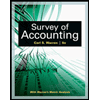
Concept explainers
(a)
T-account:
T-account refers to an individual account, where the increases or decreases in the value of specific asset, liability,
This account is referred to as the T-account, because the alignment of the components of the account resembles the capital letter ‘T’.’ An account consists of the three main components which are as follows:
- (a) The title of the account
- (b) The left or debit side
- (c) The right or credit side
To prepare: The T-accounts to enter the opening balances of L Company as on September 30, 2017.
(a)
Explanation of Solution
Common stock account:
| Common stock | |||
| Sep, 30 | $15,000 | ||
| Bal. | $15,000 | ||
Equipment account:
| Equipment | |||
| Sep, 30 | $8,000 | ||
| Bal. | $8,000 | ||
Account receivable account:
| Accounts receivable | |||
| Sep, 30 | $2,600 | ||
| Bal. | $2,600 | ||
Unearned service revenue account:
| Unearned service revenue | |||
| Sep, 30 | $1,100 | ||
| Bal. | $1,100 | ||
Accounts payable account:
| Accounts payable | |||
| Sep, 30 | $4,800 | ||
| Bal. | $4,800 | ||
| Retained earnings | |||
| Sep, 30 | $11,000 | ||
| Bal. | $11,000 | ||
Cash account:
| Cash | |||
| Sep, 30 | $19,200 | ||
| Bal. | $19,200 | ||
Supplies account:
| Supplies | |||
| Sep, 30 | $2,100 | ||
| Bal. | $2,100 | ||
(b)
Journal:
Journal is the method of recording monetary business transactions in chronological order. It records the debit and credit aspects of each transaction to abide by the double-entry system.
Rules of Debit and Credit:
Following rules are followed for debiting and crediting different accounts while they occur in business transactions:
- Debit, all increase in assets, expenses and dividends, all decrease in liabilities, revenues and stockholders’ equities.
- Credit, all increase in liabilities, revenues, and stockholders’ equities, all decrease in assets, expenses.
To journalize: the transaction as given.
(b)
Answer to Problem 3.6AP
| Date | Account Title and Explanation | Debit ($) | Credit ($) |
| Oct 5, 2017 | Cash | 1,300 | |
| Accounts receivable | 1,300 | ||
| (To record the cash received from customer ) |
Table-1
| Date | Account Title and Explanation | Debit ($) | Credit ($) |
| Oct 10, 2017 | Accounts receivable | 5,100 | |
| Service revenue | 5,100 | ||
| (To record the service provided on account to customer ) |
Table-2
| Date | Account Title and Explanation | Debit ($) | Credit ($) |
| Oct 15, 2017 | Salaries and wages expenses | 1,200 | |
| Cash | 1,200 | ||
| (To record the salaries paid in the month of October ) |
Table-3
| Date | Account Title and Explanation | Debit ($) | Credit ($) |
| Oct 17, 2017 | Cash | 600 | |
| Service revenue | 600 | ||
| (To record the service provided in cash to customer ) |
Table-4
| Date | Account Title and Explanation | Debit ($) | Credit ($) |
| Oct 20, 2017 | Accounts payable | 1,900 | |
| Cash | 1,900 | ||
| (To record the cash paid to creditor) |
Table-5
| Date | Account Title and Explanation | Debit ($) | Credit ($) |
| Oct 29, 2017 | Dividend | 300 | |
| Cash | 300 | ||
| (To record the dividend paid in cash) |
Table-6
| Date | Account Title and Explanation | Debit ($) | Credit ($) |
| Oct 31, 2017 | Utilities | 400 | |
| Cash | 400 | ||
| (To record the payment of utilities in cash) |
Table-7
Explanation of Solution
Oct 5, 2017
- Cash is an asset and increased, hence debit cash for $1,300.
- Accounts receivable is an asset and decreased, hence credit account receivable for $1,300.
Oct 10, 2017
- Account receivable is an asset and increased, hence debit the Account receivable for $5,100.
- Service revenue is a component of shareholders’ equity and has increased, hence credit the service revenue for $5,100.
Oct 15, 2017
- Salaries and wages expense is a component of stockholders’ equity and has increased, hence debit the salaries and wages expenses for $1,200.
- Cash is an asset and has decreased, hence credit cash for $1,200.
Oct 17, 2017
- Cash is an asset and increased, hence debit the cash for $600.
- Service revenue is a component of shareholders’ equity and has increased, hence credit the service revenue for $600.
Oct 20, 2017
- Accounts Payable is a liability and has decreased, hence debit Accounts Payable for $1,900.
- Cash is an asset and has decreased, hence credit cash for $1,900.
Oct 29, 2017
- Dividend is a component of stockholders’ equity and has increased, hence debit dividend for $300.
- Cash is an asset and has decreased, hence credit cash for $300.
Oct 31, 2017
- Utilities expense is a component of stockholders’ equity and has increased; hence debit the utilities for $400.
- Cash is an asset and has decreased, hence credit cash for $400.
(c)
To post: the transaction to ledger accounts of L Company on October 31, 2017.
(c)
Explanation of Solution
Account receivable account:
| Accounts receivable | |||
| Oct, 1 Bal. | $2,600 | Oct, 5 | $1,300 |
| Oct, 10 | $5,100 | ||
| Total | $7,700 | Total | $1,300 |
| Bal. | $6,400 | ||
Accounts payable account:
| Accounts payable | |||
| Oct, 20 | $1900 |
Oct, 1 Bal. | $4,800 |
| Bal. | $2,900 | ||
Service revenue account:
| Service revenue | |||
|
Oct, 10 Oct, 17 |
$5,100 $ 600 | ||
| Bal. | $5,700 | ||
Salaries and wages expenses account:
| Salaries and wages expenses | |||
| Oct, 15 | $1,200 | ||
| Bal. | $1,200 | ||
Dividend account:
| Dividend | |||
| Oct, 29 | $300 | ||
| Bal. | $300 | ||
Utilities account:
| Utilities | |||
| Oct, 31 | $400 | ||
| Bal. | $400 | ||
Cash account:
| Cash | |||
| Oct, 1 | $19,200 | Oct, 15 | $1,200 |
| Oct, 5 | $1,300 | Oct, 20 | $1,900 |
| Oct, 17 | $ 600 | Oct, 29 | $ 300 |
| Oct, 31 | $ 400 | ||
| Total | $21,100 | Total | $3,800 |
| Bal. | $17,300 | ||
(d)
Trial balance is the list of accounts, and their debit and credit balances at a given time. It is usually prepared at end of the accounting period. Debit balances are listed in left column and credit balances are listed in right column. The totals of debit and credit column should be equal. Trial balance is useful in the preparation of the financial statements.
To prepare: a trial balance as on October 31, 2017.
(d)
Explanation of Solution
| Trial balance | ||
| L Company | ||
| October 31, 2017 | ||
| Particulars | Debit $ | Credit $ |
| Common stock | 15,000 | |
| Equipment | 8,000 | |
| Retained earnings | 11,000 | |
| Accounts payable | 2,900 | |
| Unearned service revenue | 1,100 | |
| Dividends | 300 | |
| Service revenue | 5,700 | |
| Salaries and wages expenses | 1,200 | |
| Utilities expenses | 400 | |
| Accounts receivable | 6,400 | |
| Supplies | 2,100 | |
| Cash | 17,300 | |
| 35,700 | 35,700 | |
Table-8
Thus, the total of debit, and credit columns of a trial balance are $35,700 and agreed.
Want to see more full solutions like this?
Chapter 3 Solutions
FINANCIAL ACCOUNTING>IC<
- Kenneth Manufacturing produces two models of its kitchen tables, the Classic and the Royal. The Classic model requires 5,000 direct labor hours, and the Royal model requires 25,000 direct labor hours. The company produces 4,000 units of the Classic model and 1,500 units of the Royal model each year. The company produces the Classic model in batch sizes of 200, while it produces the Royal model in batch sizes of 150. The company expects to incur $180,000 of total setup costs this year. How much of the setup costs are allocated to the Classic model using ABC costing? A. $80,000 B. $100,000 C. $160,000 D. $120,000arrow_forwardKenneth Manufacturing produces two models of its kitchen tables, the Classic and the Royal. The Classic model requires 5,000 direct labor hours, and the Royal model requires 25,000 direct labor hours. The company produces 4,000 units of the Classic model and 1,500 units of the Royal model each year. The company produces the Classic model in batch sizes of 200, while it produces the Royal model in batch sizes of 150. The company expects to incur $180,000 of total setup costs this year. How much of the setup costs are allocated to the Classic model using ABC costing? A. $80,000 B. $100,000 C. $160,000 D. $120,000 MCQarrow_forwardA business purchased office supplies for $750 and used $520 worth during the accounting period. What is the value of office supplies that should appear on the balance sheet at the end of the period? Questionarrow_forward
 Cornerstones of Financial AccountingAccountingISBN:9781337690881Author:Jay Rich, Jeff JonesPublisher:Cengage Learning
Cornerstones of Financial AccountingAccountingISBN:9781337690881Author:Jay Rich, Jeff JonesPublisher:Cengage Learning Survey of Accounting (Accounting I)AccountingISBN:9781305961883Author:Carl WarrenPublisher:Cengage Learning
Survey of Accounting (Accounting I)AccountingISBN:9781305961883Author:Carl WarrenPublisher:Cengage Learning Financial AccountingAccountingISBN:9781305088436Author:Carl Warren, Jim Reeve, Jonathan DuchacPublisher:Cengage Learning
Financial AccountingAccountingISBN:9781305088436Author:Carl Warren, Jim Reeve, Jonathan DuchacPublisher:Cengage Learning- Principles of Accounting Volume 1AccountingISBN:9781947172685Author:OpenStaxPublisher:OpenStax College
 Financial Accounting: The Impact on Decision Make...AccountingISBN:9781305654174Author:Gary A. Porter, Curtis L. NortonPublisher:Cengage Learning
Financial Accounting: The Impact on Decision Make...AccountingISBN:9781305654174Author:Gary A. Porter, Curtis L. NortonPublisher:Cengage Learning




